Quantifying Creep on the Laohushan Fault Using Dense Continuous GNSS
Abstract
:1. Introduction

2. GNSS Data and Processing
2.1. GNSS Observations and Data Collection
2.2. GNSS Data Processing
2.2.1. The Baseline Time Series of GNSS Profile
2.2.2. Regional GNSS Horizontal Velocity Field
3. GNSS Baseline Time Series
4. GNSS Profiles and Inversions
4.1. Methods and Solution
4.2. Results of GNSS Profile Inversion
5. Discussion
5.1. Comparison with Existing InSAR Results
5.2. Temporal and Spatial Variation in Creep Motion on the Laohushan Fault
5.3. Regional Fault Movement and Earthquake Hazard
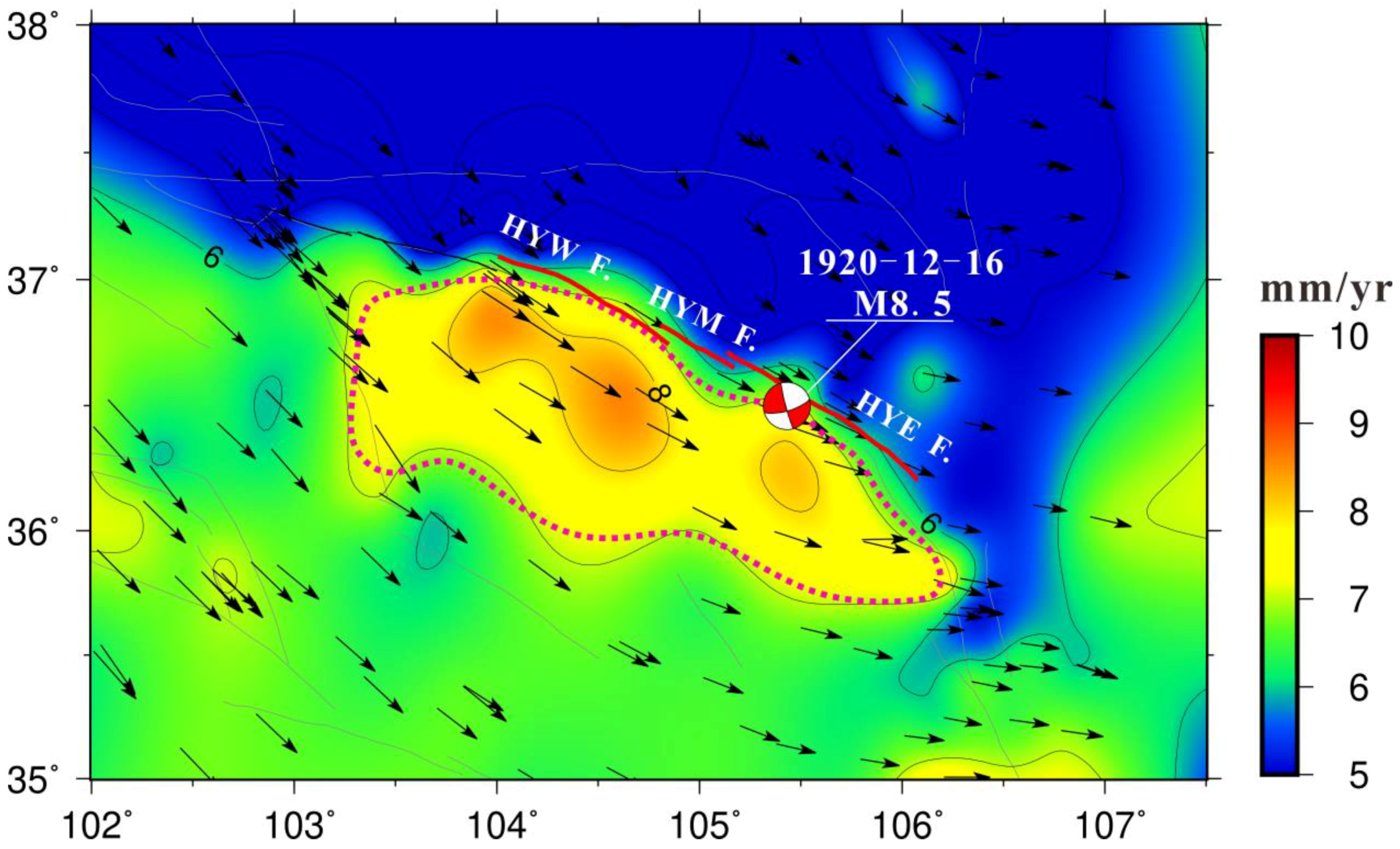
6. Conclusions
Author Contributions
Funding
Data Availability Statement
Acknowledgments
Conflicts of Interest
References
- Burgmann, R.; Schmidt, D.; Nadeau, R.M.; d’Alessio, M.; Fielding, E.; Manaker, D.; Murray, M.H. Earthquake potential along the northern Hayward fault, California. Science 2000, 289, 1178–1182. [Google Scholar] [CrossRef]
- Ryder, I.; Burgmann, R. Spatial variations in slip deficit on the central San Andreas Fault from InSAR. Geophys. J. Int. 2008, 175, 837–852. [Google Scholar] [CrossRef]
- Cattin, R.; Avouac, J.P. Modeling mountain building and the seismic cycle in the Himalaya of Nepal. J. Geophys. Res. Solid Earth 2000, 105, 13389–13407. [Google Scholar] [CrossRef]
- Barbot, S.; Lapusta, N.; Avouac, J.P. Under the hood of the earthquake machine: Toward predictive modeling of the seismiccycle. Science 2012, 336, 707–710. [Google Scholar] [CrossRef] [PubMed]
- Scholz, C.H. Earthquakes and friction laws. Nature 1998, 391, 37–42. [Google Scholar] [CrossRef]
- Kaneko, Y.; Avouac, J.P.; Lapusta, N. Towards inferring earthquake patterns from geodetic observations of interseismic coupling. Nat. Geosci. 2010, 3, 363–369. [Google Scholar] [CrossRef]
- Jolivet, R.; Candela, T.; Lasserre, C.; Renard, F.; Klinger, Y.; Doin, M.P. The burst-like behavior of aseismic slip on a rough fault: The creeping section of the Haiyuan fault, China. Bull. Seismol. Soc. Am. 2015, 105, 480–488. [Google Scholar] [CrossRef]
- Lohman, R.B.; McGuire, J.J. Earthquake swarms driven by aseismic creep in the Salton Trough, California. J. Geophys. Res. 2007, 112, B04405. [Google Scholar] [CrossRef]
- Zhang, J.; Wen, X.Z.; Cao, J.L.; Yan, W.; Yang, Y.L.; Su, Q. Surface creep and slip-behavior segmentation along the northwestern Xianshuihe fault zone of southwestern China determined from decades of fault-crossing short-baseline and short-level surveys. Tectonophysics 2018, 722, 356–372. [Google Scholar] [CrossRef]
- Lisowski, M.; Prescott, W.H. Short-range distance measurements along the San Andreas fault system in central California, 1975 to 1979. Bull. Seismol. Soc. Am. 1981, 71, 1607–1624. [Google Scholar] [CrossRef]
- Ambraseys, N.N. Some characteristic features of the Anatolian fault zone. Tectonophysics 1970, 9, 143–165. [Google Scholar] [CrossRef]
- Cakir, Z.; Akoglu, A.M.; Belabbes, S.; Ergintav, S.; Meghraoui, M. Creeping along the Ismetpasa section of the North Anatolian fault (Western Turkey): Rate and extent from InSAR. Earth Planet. Sci. Lett. 2005, 238, 225–234. [Google Scholar] [CrossRef]
- Ohzono, M.; Sagiya, T.; Hirahara, K.; Hashimoto, M.; Takeuchi, A.; Hoso, Y.; Wada, Y.; Onoue, K.; Ohya, F. Doke Strain accumulation process around the Atotsugawa fault system in the Niigata-Kobe Tectonic Zone, central Japan. Geophys. J. Int. 2011, 184, 977–990. [Google Scholar] [CrossRef]
- Anderlini, L.; Serpelloni, E.; Belardinelli, M.E. Creep and locking of a low-angle normal fault: Insights from the Altotiberina fault in the northern Apennines (Italy). Geophys. Res. Lett. 2016, 43, 4321–4329. [Google Scholar] [CrossRef]
- Hamiel, Y.; Piatibratova, O.; Mizrahi, Y. Creep along the northern Jordan Valley section of the Dead Sea Fault. Geophys. Res. Lett. 2016, 43, 2494–2501. [Google Scholar] [CrossRef]
- Li, C.; Zhang, P.Z.; Yin, J.; Min, W. Late Quaternary left-lateral slip rate of the Haiyuan fault, northeastern margin of the Tibetan Plateau. Tectonics 2009, 28. [Google Scholar] [CrossRef]
- Liu-Zeng, J.; Shao, Y.; Klinger, Y.; Xie, K.; Yuan, D.; Lei, Z. Variability in magnitude of paleoearthquakes revealed by trenching and historical records, along the Haiyuan Fault, China. J. Geophys. Res. Solid Earth 2015, 120, 8304–8333. [Google Scholar] [CrossRef]
- Shao, Y.; Liu-Zeng, J.; Van der Woerd, J.; Klinger, Y.; Oskin, M.E.; Zhang, J.; Yao, W. Late Pleistocene slip rate of the central Haiyuan fault constrained from optically stimulated luminescence, 14C, and cosmogenic isotope dating and high-resolution topography. GSA Bull. 2021, 133, 1347–1369. [Google Scholar] [CrossRef]
- Jolivet, R.; Lasserre, C.; Doin, M.P.; Guillaso, S.; Peltzer, G.; Dailu, R.; Sun, Z.-K.; Shen, X.X. Shallow creep on the Haiyuan fault (Gansu, China) revealed by SAR interferometry. J. Geophys. Res. Solid Earth 2012, 117, B06401. [Google Scholar] [CrossRef]
- Gan, W.; Zhang, P.; Shen, Z.K.; Niu, Z.; Wang, M.; Wan, Y.; Cheng, J. Present-day crustal motion within the Tibetan Plateau inferred from GPS measurements. J. Geophys. Res. Solid Earth 2007, 112, B08416. [Google Scholar] [CrossRef]
- Li, Y.; Liu, M.; Wang, Q.; Cui, D. Present-day crustal deformation and strain transfer in northeastern Tibetan Plateau. Earth Planet. Sci. Lett. 2018, 487, 179–189. [Google Scholar] [CrossRef]
- Jolivet, R.; Lasserre, C.; Doin, M.P.; Peltzer, G.; Avouac, J.P.; Sun, J.; Dailu, R. Spatio-temporal evolution of aseismic slip along the Haiyuan fault, China: Implications for fault frictional properties. Earth Planet. Sci. Lett. 2013, 377, 23–33. [Google Scholar] [CrossRef]
- Li, Y.; Nocquet, J.M.; Shan, X.; Song, X. Geodetic observations of shallow creep on the Laohushan-Haiyuan fault, northeastern Tibet. J. Geophys. Res. Solid Earth 2021, 126, e2020JB021576. [Google Scholar] [CrossRef]
- Qiao, X.; Qu, C.; Shan, X.; Zhao, D.; Liu, L. Interseismic slip and coupling along the Haiyuan fault zone constrained by InSAR and GPS measurements. Remote Sens. 2021, 13, 3333. [Google Scholar] [CrossRef]
- Huang, Z.; Zhou, Y.; Qiao, X.; Zhang, P.; Cheng, X. Kinematics of the ∼1000 km Haiyuan fault system in northeastern Tibet from high-resolution Sentinel-1 InSAR velocities: Fault architecture, slip rates, and partitioning. Earth Planet. Sci. Lett. 2022, 583, 117450. [Google Scholar] [CrossRef]
- Guo, N.; Wu, Y.; Su, G. Analysis of the fault slip, creep, and coupling characteristics of the Maomaoshan-Laohushan-Haiyuan Fault using InSAR and GNSS measurements. Tectonophysics 2023, 863, 229988. [Google Scholar] [CrossRef]
- Hao, M.; Wang, Q.; Shen, Z.; Cui, D.; Ji, L.; Li, Y.; Qin, S. Present day crustal vertical movement inferred from precise leveling data in eastern margin of Tibetan Plateau. Tectonophysics 2014, 632, 281–292. [Google Scholar] [CrossRef]
- Xu, X.; Tong, X.; Sandwell, D.T.; Milliner, C.W.; Dolan, J.F.; Hollingsworth, J.; Ayoub, F. Refining the shallow slip deficit. Geophys. J. Int. 2016, 204, 1867–1886. [Google Scholar] [CrossRef]
- Marchandon, M.; Hollingsworth, J.; Radiguet, M. Origin of the shallow slip deficit on a strike slip fault: Influence of elastic structure, topography, data coverage, and noise. Earth Planet. Sci. Lett. 2021, 554, 116696. [Google Scholar] [CrossRef]
- Wu, X.; Xu, X.; Yu, G.; Ren, J.; Yang, X.; Chen, G.; Hao, H. The China Active Faults Database (CAFD) and its web system. Earth Syst. Sci. Data 2024, 16, 3391–3417. [Google Scholar] [CrossRef]
- Pang, Y.J.; Zhang, H.; Cheng, H.H.; Dong, P.Y.; Wang, J.J.; Shi, Y.L. Three-dimensional numerical simulation of pull-apart basins: An example of the Laolongwan basin in the Haiyuan fault zone. Chin. J. Geophys. 2015, 58, 3615–3626. [Google Scholar] [CrossRef]
- Song, Z.; Zhang, G.; Liu, J.; Yin, J.; Xue, Y.; Song, X. Disaster Information Catalog of Global Earthquakes (9999 B.C. to 2010 A.D.); Seismological Press: Beijing, China, 2011; (In Chinese with English Preface). [Google Scholar]
- Wang, M.; Shen, Z.K.; Gan, W.J.; Liao, H.; Li, T.; Ren, J.; Qiao, X.; Wang, Q.; Yang, Y.; Li, P.; et al. GPS Continuous Monitoring of Dynamic Evolution of Deformation Field of Xianshuihe Fault. Sci. China Ser. D 2008, 38, 575–581. [Google Scholar]
- Huang, L.R.; Fu, Y. Analysis on the noises from continuously monitoring GPS sites. Acta Seismol. Sin. 2007, 20, 197–202. [Google Scholar] [CrossRef]
- Hao, M.; Li, Y.; Wang, Q.; Zhuang, W.; Qu, W. Present-day crustal deformation within the western Qinling Mountains and its kinematic implications. Surv. Geophys. 2021, 42, 1–19. [Google Scholar] [CrossRef]
- Herring, T.A.; King, R.W.; McClusky, S.C. GAMIT Reference Manual, GNSS Analysis at MIT, Release 10.6; Massachusetts Institute of Technology: Cambridge, MA, USA, 2015. [Google Scholar]
- Herring, T.A.; King, R.W.; McClusky, S.C. GAMIT Reference Manual, Global Kalman Filter VLBI and GNSS Analysis Program, Release 10.6; Massachusetts Institute of Technology: Cambridge, MA, USA, 2015. [Google Scholar]
- Petit, G. IERS Conventions (2010); U.S. Naval Observatory Observatoire de Paris: Paris, France, 2010. [Google Scholar]
- Lyard, F.; Lefevre, F.; Letellier, T.; Francis, O. Modelling the global ocean tides: Modern insights from FES2004. Ocean. Dyn. 2006, 56, 394–415. [Google Scholar] [CrossRef]
- Altamimi, Z.; Métivier, L.; Rebischung, P.; Rouby, H.; Collilieux, X. ITRF2014 plate motion model. Geophys. J. Int. 2017, 209, 1906–1912. [Google Scholar] [CrossRef]
- Wang, M.; Shen, Z.K. Present-day crustal deformation of continental China derived from GPS and its tectonic implications. J. Geophys. Res. Solid Earth 2020, 125, e2019JB018774. [Google Scholar] [CrossRef]
- Li, Y.; Shan, X.; Qu, C.; Zhang, Y.; Song, X.; Jiang, Y.; Wang, C. Elastic block and strain modeling of GPS data around the Haiyuan-Liupanshan fault, northeastern Tibetan Plateau. J. Asian Earth Sci. 2017, 150, 87–97. [Google Scholar] [CrossRef]
- Zhuang, W.; Cui, D.; Hao, M.; Song, S.; Li, Z. Geodetic constraints on contemporary three-dimensional crustal deformation in the Laji Shan–Jishi Shan tectonic belt. Geod. Geodyn. 2023, 14, 589–596. [Google Scholar] [CrossRef]
- Fattahi, H.; Amelung, F. InSAR observations of strain accumulation and fault creep along the Chaman Fault system, Pakistan and Afghanistan. Geophys. Res. Lett. 2016, 43, 8399–8406. [Google Scholar] [CrossRef]
- Savage, J.C.; Burford, R.O. Geodetic determination of relative plate motion in central California. J. Geophys. Res. 1973, 78, 832–845. [Google Scholar] [CrossRef]
- Savage, J.C. A dislocation model of strain accumulation and release at a subduction zone. J. Geophys. Res. Solid Earth 1983, 88, 4984–4996. [Google Scholar] [CrossRef]
- Savage, J.C. Viscoelastic-coupling model for the earthquake cycle driven from below. J. Geophys. Res. Solid Earth 2000, 105, 25525–25532. [Google Scholar] [CrossRef]
- Harris, R.A. Large earthquakes and creeping faults. Rev. Geophys. 2017, 55, 169–198. [Google Scholar] [CrossRef]
- Li, Z.; Hao, M.; Hammond, W.C.; Cheng, F.; Zhang, G.; Wang, Q.; Liu, L.; Hou, B.; Gan, W. Geodetic constraints on three-component motion of the Ordos block (China) and their implications for lithospheric dynamics. Geol. Soc. Am. Bull. 2024. [Google Scholar] [CrossRef]
- Liu, C.; Ji, L.; Zhu, L.; Xu, C.; Qiu, J. Interseismic strain rate distribution model of the Altyn Tagh Fault constrained by InSAR and GPS. Earth Planet. Sci. Lett. 2024, 642, 118884. [Google Scholar] [CrossRef]
- Hao, M.; Wang, Q.L.; Cui, D.X.; Liu, L.W.; Zhou, L. Present-day crustal vertical motion around the Ordos block constrained by precise leveling and GNSS data. Surv. Geophys. 2016, 37, 923–936. [Google Scholar] [CrossRef]
- Marone, C.J.; Scholtz, C.H.; Bilham, R. On the mechanics of earthquake afterslip. J. Geophys. Res. Solid Earth 1991, 96, 8441–8452. [Google Scholar] [CrossRef]
- Tian, Z.; Freymueller, J.T.; Yang, Z. Postseismic Deformation due to the 2012 Mw 7.8 Haida Gwaii and 2013 Mw 7.5 Craig Earthquakes and its Implications for Regional Rheological Structure. J. Geophys. Res. Solid Earth 2021, 126, e2020JB020197. [Google Scholar] [CrossRef]
- Tian, Z.; Freymueller, J.T.; Yang, Z.; Li, Z.; Sun, H. Frictional Properties and Rheological Structure at the Ecuadorian Subduction Zone Revealed by the Postseismic Deformation Due to the 2016 Mw 7.8 Pedernales (Ecuador) Earthquake. J. Geophys. Res. Solid Earth 2023, 128, e2022JB025043. [Google Scholar] [CrossRef]
- Liu, B.Y.; Yin, Z.W.; Yuan, D.Y.; Li, L.; Wang, W. The research on fault plane solution and geometric meaning of the Laohushan fault in the northeastern Tibetan plateau. Seismol. Geol. 2023, 42, 1354–1369. [Google Scholar]
- Liu-Zeng, J.; Klinger, Y.; Xu, X.; Lasserre, C.; Chen, G.; Chen, W.; Zhang, B. Millennial recurrence of large earthquakes on the Haiyuan fault near Songshan, Gansu Province, China. Bull. Seismol. Soc. Am. 2007, 97, 14–34. [Google Scholar] [CrossRef]
- Li, Y.; Shan, X.; Gao, Z.; Qu, C. Interseismic Coupling–Based Stochastic Slip Modeling of the 1920 Ms 8.5 Haiyuan Earthquake. Seismol. Res. Lett. 2024, 95, 870–878. [Google Scholar] [CrossRef]
- Loveless, J.P.; Meade, B.J. Partitioning of localized and diffuse deformation in the Tibetan Plateau from joint inversions of geologic and geodetic observations. Earth Planet. Sci. Lett. 2011, 303, 11–24. [Google Scholar] [CrossRef]
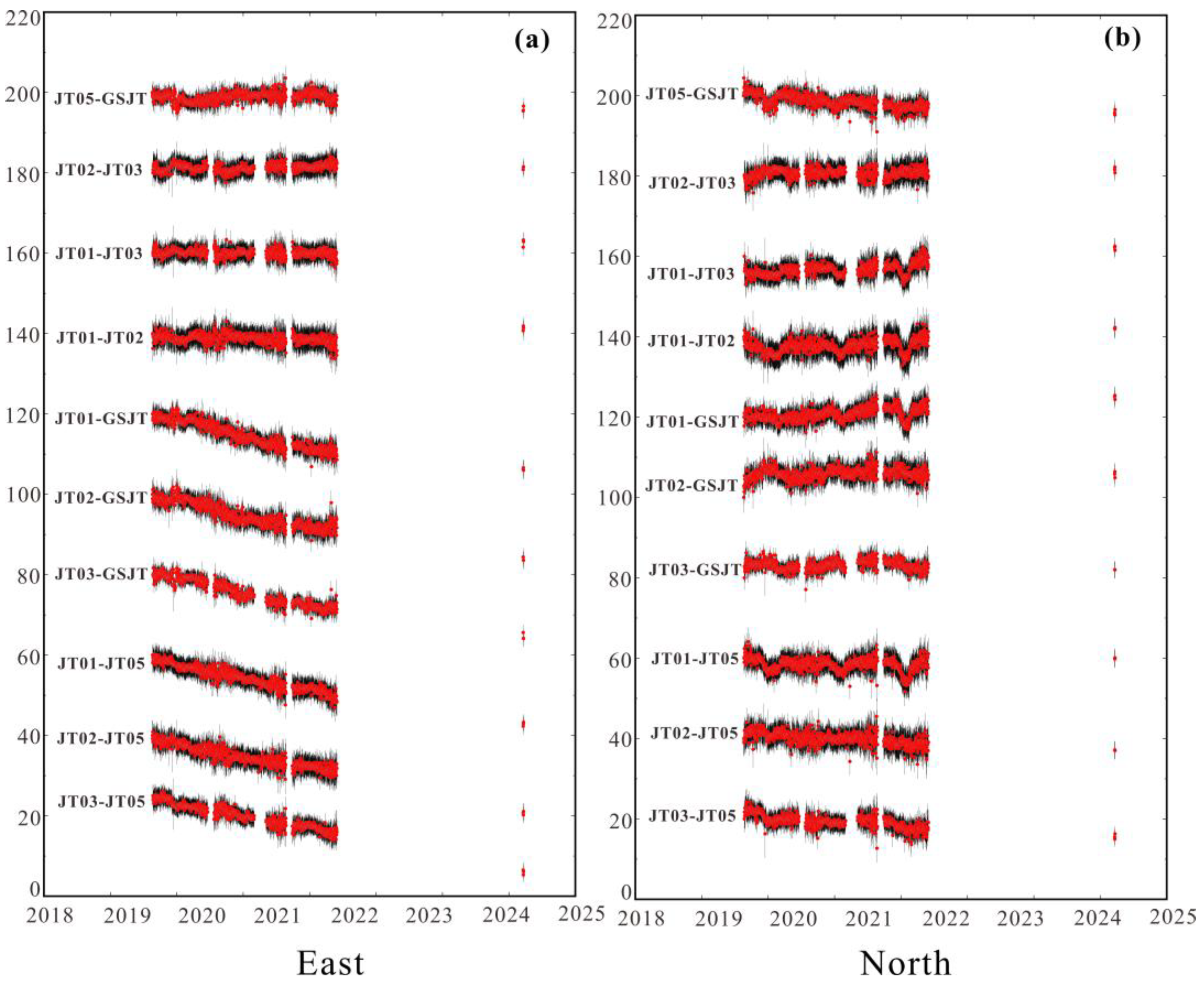


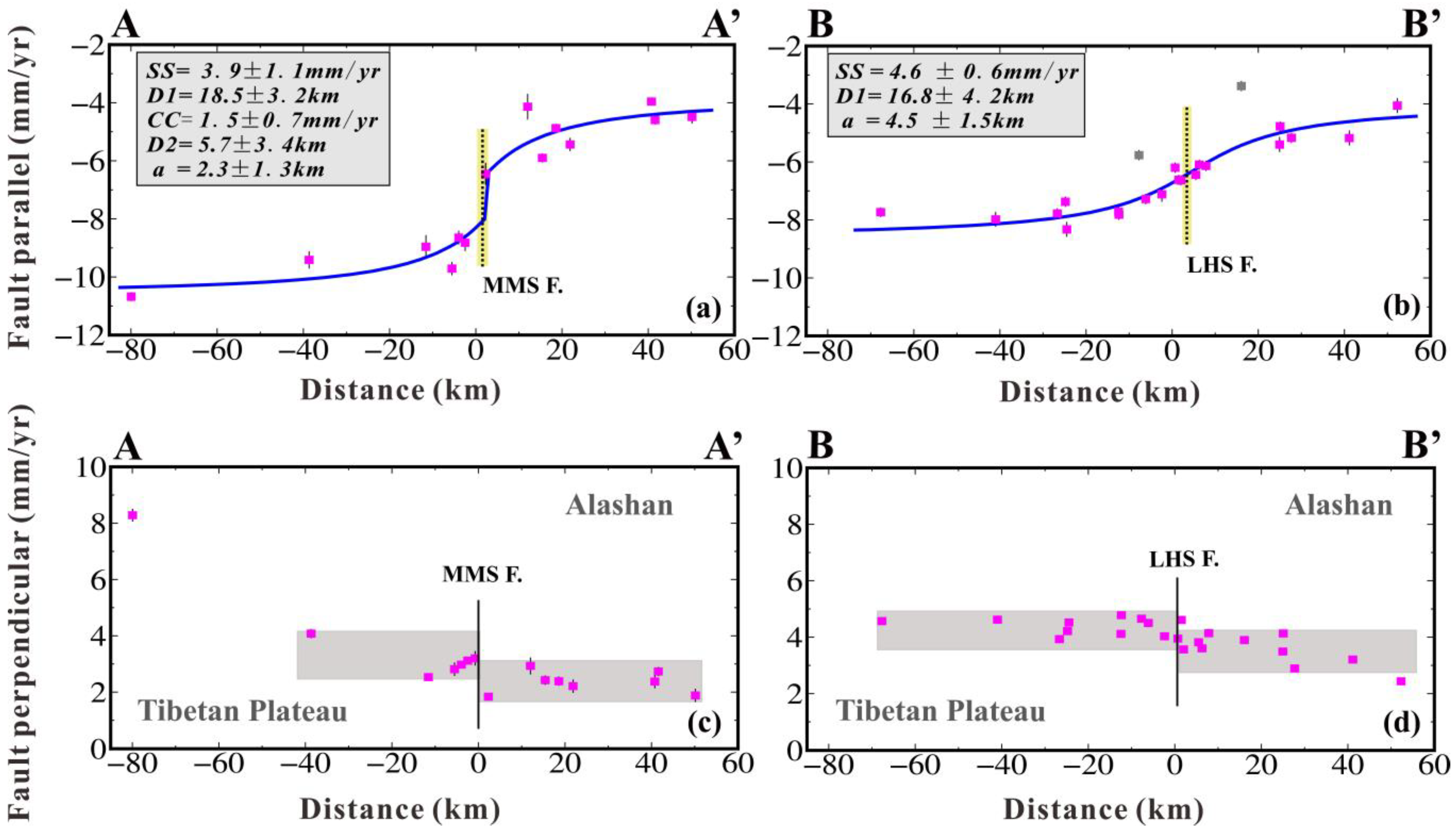
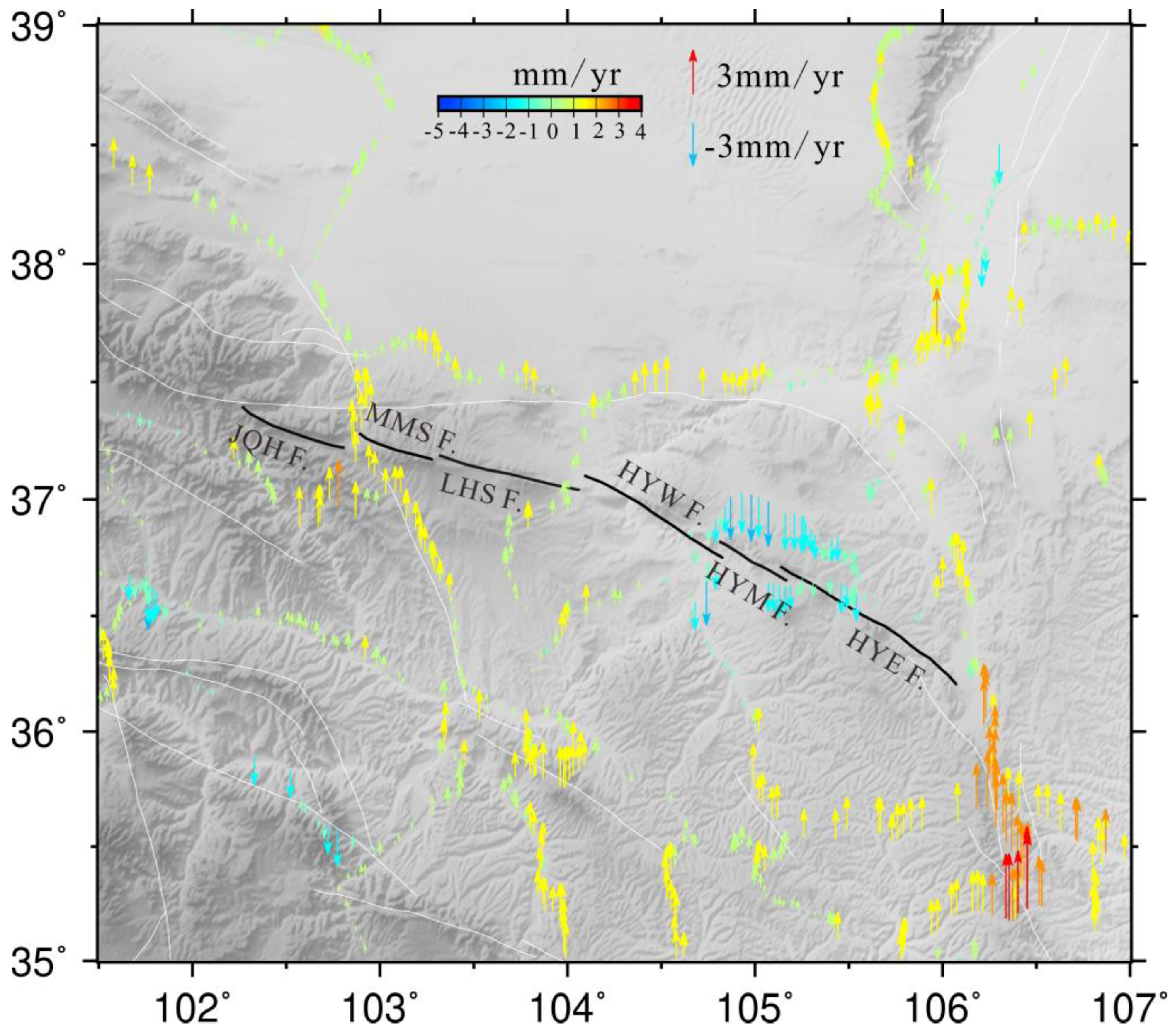

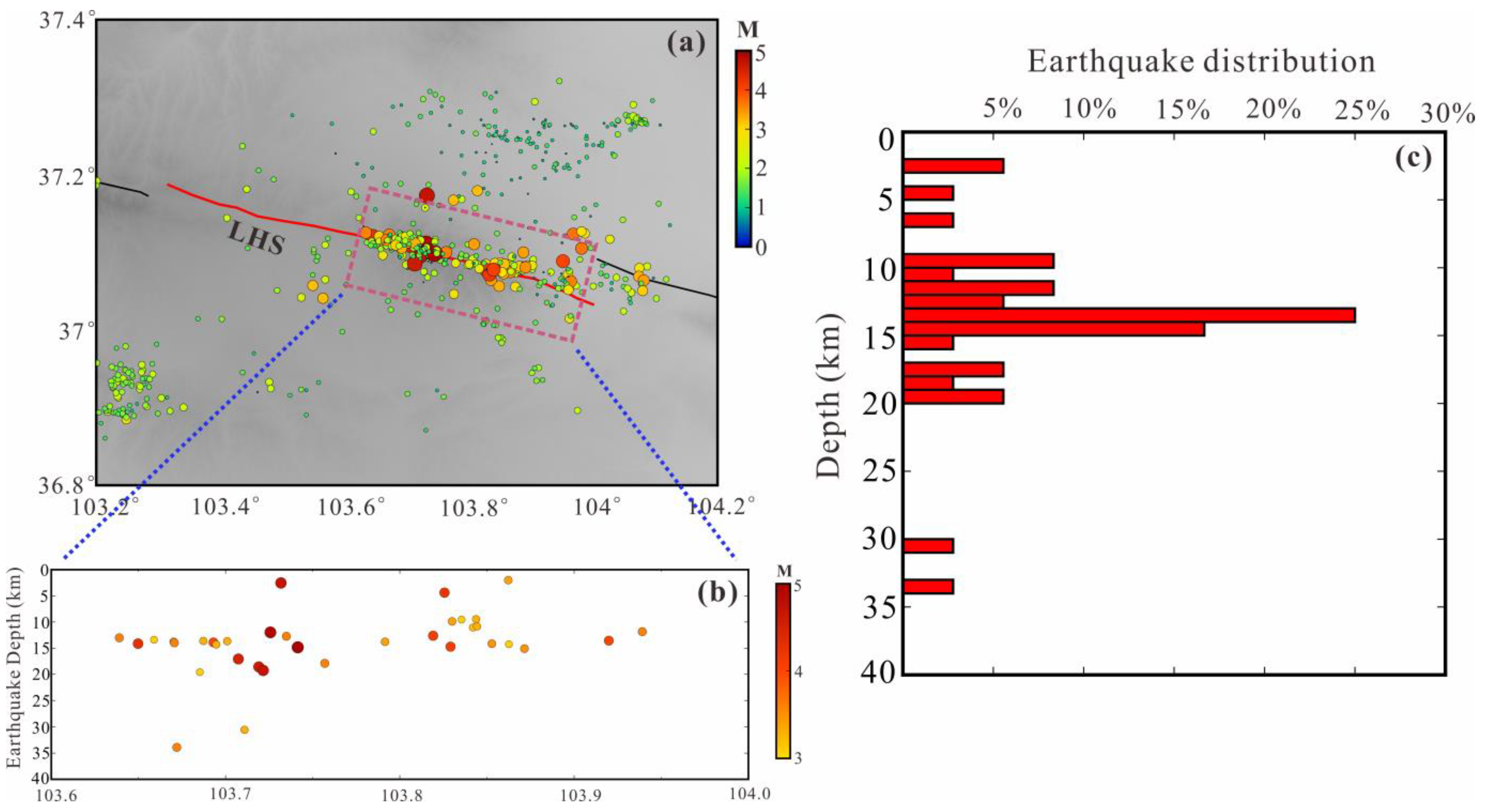
| Category | Baseline Name | Parallel Fault Rate (mm/yr) | Parallel Fault Rate Error (mm/yr) | Perpendicular Fault Rate (mm/yr) | Perpendicular Fault Rate Error (mm/yr) |
|---|---|---|---|---|---|
| Cross-Fault Baselines | JT03-JT05 | 2.81 | 0.10 | −1.86 | 0.13 |
| JT02-JT05 | 3.02 | 0.15 | −1.57 | 0.13 | |
| JT01-JT05 | 3.04 | 0.11 | −1.04 | 0.17 | |
| JT03-GSJT | 3.38 | 0.12 | −0.68 | 0.12 | |
| JT02-GSJT | 3.25 | 0.15 | −0.40 | 0.15 | |
| JT01-GSJT | 3.64 | 0.13 | 0.11 | 0.14 | |
| Same-Side Baselines | JT01-JT02 | 0.38 | 0.12 | 0.55 | 0.17 |
| JT01-JT03 | 0.21 | 0.10 | 0.81 | 0.14 | |
| JT02-JT03 | −0.19 | 0.10 | 0.23 | 0.12 | |
| JT05-GSJT | 0.58 | 0.13 | 1.17 | 0.14 |
| Fault Name | Data Detection | Creep Rate (mm/yr) | Creep Depth (km) | References |
|---|---|---|---|---|
| LaoHuShan Fault | InSAR (D) | 5 ± 1 | - | Jolivet et al., 2013 [19] |
| InSAR (A/D) + GNSS (Far-field) | 2.5 ± 0.4 | 0~4–8 | Li et al., 2021 [23] | |
| InSAR (D) + GNSS (Far-field) | 4.5~4.8 | 0~0.7 ± 1.3 | Qiao et al., 2021 [24] | |
| InSAR (A/D) + GNSS (Far-field) | 2.9 ± 0.4 | 0~16.9 ± 8.3 | Huang et al., 2022 [25] | |
| InSAR (A/D) + GNSS (Far-field) | 2.1 ± 0.1 | 0~0.3 ± 0.06 | Guo et al., 2023 [26] | |
| GNSS (Near-field) | 1.5 ± 0.7 | 0~5.7 ± 3.4 | Our Results |
Disclaimer/Publisher’s Note: The statements, opinions and data contained in all publications are solely those of the individual author(s) and contributor(s) and not of MDPI and/or the editor(s). MDPI and/or the editor(s) disclaim responsibility for any injury to people or property resulting from any ideas, methods, instructions or products referred to in the content. |
© 2024 by the authors. Licensee MDPI, Basel, Switzerland. This article is an open access article distributed under the terms and conditions of the Creative Commons Attribution (CC BY) license (https://creativecommons.org/licenses/by/4.0/).
Share and Cite
Zhuang, W.; Li, Y.; Hao, M.; Song, S.; Liu, B.; Fan, L. Quantifying Creep on the Laohushan Fault Using Dense Continuous GNSS. Remote Sens. 2024, 16, 3746. https://doi.org/10.3390/rs16193746
Zhuang W, Li Y, Hao M, Song S, Liu B, Fan L. Quantifying Creep on the Laohushan Fault Using Dense Continuous GNSS. Remote Sensing. 2024; 16(19):3746. https://doi.org/10.3390/rs16193746
Chicago/Turabian StyleZhuang, Wenquan, Yuhang Li, Ming Hao, Shangwu Song, Baiyun Liu, and Lihong Fan. 2024. "Quantifying Creep on the Laohushan Fault Using Dense Continuous GNSS" Remote Sensing 16, no. 19: 3746. https://doi.org/10.3390/rs16193746





